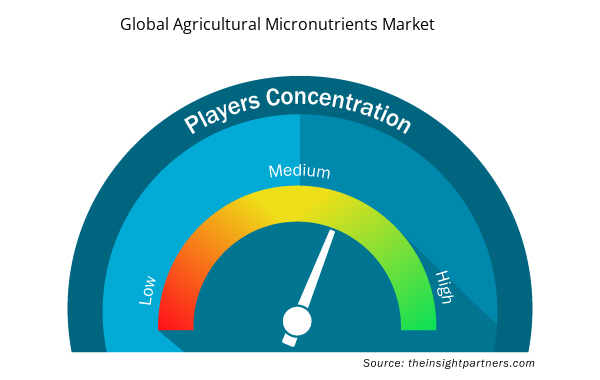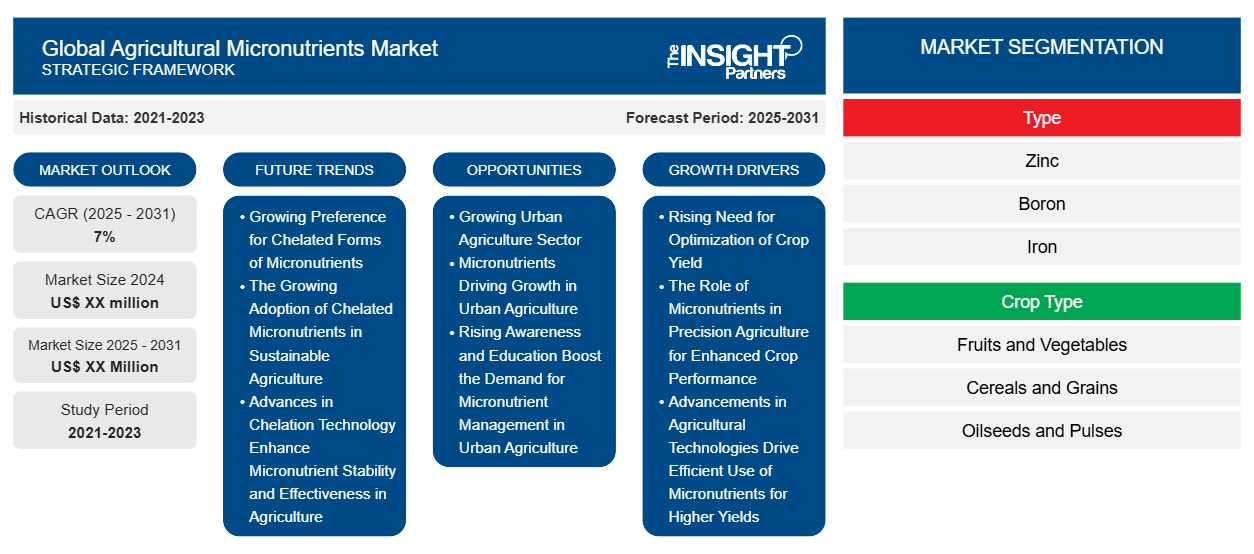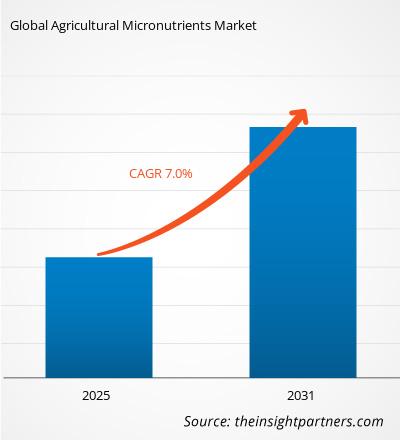Der Markt für landwirtschaftliche Mikronährstoffe wird voraussichtlich von 2023 bis 2031 eine durchschnittliche jährliche Wachstumsrate von 7 % verzeichnen, wobei die Marktgröße von XX Millionen US-Dollar im Jahr 2023 auf XX Millionen US-Dollar im Jahr 2031 wachsen wird.
Der Bericht ist nach Typ (Zink, Bor, Eisen, Molybdän, Kupfer, Mangan und andere) segmentiert. Der Bericht präsentiert außerdem Analysen basierend auf dem Erntetyp (Obst und Gemüse, Getreide und Körner, Ölsaaten und Hülsenfrüchte und andere). Basierend auf der Form ist der Bericht segmentiert in (Chelatisiert und Nicht-Chelatisiert). Basierend auf der Anwendungsart ist der Bericht segmentiert in (Boden, Laub, Fertigation und andere). Die globale Analyse ist weiter auf regionaler Ebene und in den wichtigsten Ländern aufgeschlüsselt. Der Bericht bietet den Wert in USD für die oben genannte Analyse und Segmente.
Zweck des Berichts
Der Bericht „Markt für landwirtschaftliche Mikronährstoffe“ von The Insight Partners soll die aktuelle Landschaft und das zukünftige Wachstum sowie die wichtigsten treibenden Faktoren, Herausforderungen und Chancen beschreiben. Dies wird verschiedenen Geschäftspartnern Einblicke geben, wie zum Beispiel:
- Technologieanbieter/-hersteller: Um die sich entwickelnde Marktdynamik zu verstehen und die potenziellen Wachstumschancen zu kennen, damit sie fundierte strategische Entscheidungen treffen können.
- Investoren: Durchführung einer umfassenden Trendanalyse hinsichtlich der Marktwachstumsrate, der finanziellen Marktprognosen und der Chancen entlang der Wertschöpfungskette.
- Regulierungsbehörden: Zur Regulierung von Richtlinien und Überwachungsaktivitäten auf dem Markt mit dem Ziel, Missbrauch zu minimieren, das Vertrauen der Anleger zu bewahren und die Integrität und Stabilität des Marktes aufrechtzuerhalten.
Marktsegmentierung für landwirtschaftliche Mikronährstoffe
Typ
- Zink
- Bor
- Eisen
- Molybdän
- Kupfer
- Mangan
Pflanzenart
- Obst und Gemüse
- Getreide und Körner
- Ölsaaten und Hülsenfrüchte
Bilden
- Chelatisiert und nicht chelatisiert
Geographie
- Nordamerika
- Europa
- Asien-Pazifik
- Süd- und Mittelamerika
- Naher Osten und Afrika
Geographie
- Nordamerika
- Europa
- Asien-Pazifik
- Süd- und Mittelamerika
- Naher Osten und Afrika
Passen Sie diesen Bericht Ihren Anforderungen an
Sie erhalten kostenlose Anpassungen an jedem Bericht, einschließlich Teilen dieses Berichts oder einer Analyse auf Länderebene, eines Excel-Datenpakets sowie tolle Angebote und Rabatte für Start-ups und Universitäten.
- Holen Sie sich die wichtigsten Markttrends aus diesem Bericht.Dieses KOSTENLOSE Beispiel umfasst eine Datenanalyse von Markttrends bis hin zu Schätzungen und Prognosen.
Wachstumstreiber auf dem Markt für landwirtschaftliche Mikronährstoffe
- Steigender Bedarf an Optimierung der Ernteerträge: Eine der großen Auswirkungen, die dem Markt für landwirtschaftliche Mikronährstoffe zugeschrieben werden, ist die Steigerung der Ertragsoptimierung. Dies wird auf die Tendenz der Landwirte zurückzuführen sein, die Produktivität und Qualität der Ernte zu steigern, was zu einer höheren Nachfrage nach Mikronährstoffen wie Zink, Eisen und Mangan führt. Dies ist eine der entscheidenden Komponenten für Pflanzengesundheit und -ertrag, insbesondere unter widrigen Umweltbedingungen.
- Die Rolle von Mikronährstoffen in der Präzisionslandwirtschaft für eine verbesserte Ernteleistung: Mit dem rasanten Bevölkerungswachstum geht die Forderung nach einer Optimierung der landwirtschaftlichen Erträge einher, verbunden mit der Nahrungsmittelunsicherheit. Um die Mängel bei Elementen zu beheben, die sonst die Ernteleistung beeinträchtigen würden, setzen Landwirte zunehmend Düngemittel und Bodenverbesserungsmittel auf die Felder. Dieser Fokus auf die Präzisionslandwirtschaft schärft das Bewusstsein für die Rolle von Mikronährstoffen in der nachhaltigen Landwirtschaft weiter.
- Fortschritte in der Agrartechnologie ermöglichen eine effizientere Nutzung von Mikronährstoffen und damit höhere Erträge: Auch die hohe Anwendungsintensität von Mikronährstoffen ist auf Agrartechnologien zurückzuführen. Dank verbesserter Systeme zur Bodenuntersuchung und Nährstoffverwaltung können Landwirte ihre Inputmengen im Allgemeinen sorgfältiger erhöhen, was nicht nur zu höheren Erträgen führt, sondern auch zu einem sparsameren Ressourceneinsatz und damit zu einer höheren Rentabilität der landwirtschaftlichen Betriebe.
Zukünftige Trends auf dem Markt für landwirtschaftliche Mikronährstoffe
- Wachsende Vorliebe für chelatierte Formen von Mikronährstoffen: Einer der neuen Trends bei landwirtschaftlichen Mikronährstoffen ist die steigende Nachfrage nach chelatierten Formen von Mikronährstoffen. Chelatisierte Mikronährstoffe sind Mikronährstoffe, die an organische Moleküle chelatiert sind, die eine höhere Bioverfügbarkeit als herkömmliche Formen bieten und daher von Pflanzen besser aufgenommen werden und zu besseren Ernteerträgen führen.
- Die zunehmende Verwendung von chelatierten Mikronährstoffen in der nachhaltigen Landwirtschaft: Ein weiterer Vorteil der Anwendung chelatierter Mikronährstoffe, der von Landwirten entdeckt wurde, ist die gezielte Korrektur bestimmter Nährstoffmängel im Boden. Da das Umweltbewusstsein in Bezug auf Nährstoffmanagement zunimmt, werden diese Formen von immer mehr Landwirten problemlos als Methode zur Verbesserung der Pflanzengesundheit und des Ertrags übernommen. Dieser Trend steht im Einklang mit dem Aufruf an alle Nationen weltweit, eine nachhaltige Landwirtschaft einzuführen.
- Fortschritte in der Chelat-Technologie verbessern Stabilität und Wirksamkeit von Mikronährstoffen in der Landwirtschaft: Fortschritte in der Chelat-Technologie durch andere Treiber. Umsetzung weiterer Verbesserungen bei der Formulierung chelatierter Mikronährstoffe, um eine höhere Stabilität und damit Wirksamkeit zu erzielen. Solche neuen Formulierungen chelatierter Mikronährstoffe erleichtern ihre Anwendung und führen so zu besseren Ergebnissen, was beispielsweise eine breitere und systematischere Aufnahme in den Agrarsektor erzwingt.
Marktchancen für landwirtschaftliche Mikronährstoffe
- Wachsender Sektor der städtischen Landwirtschaft: Tatsächlich ist der wachsende Sektor der städtischen Landwirtschaft eine sehr bedeutende Wachstumsquelle für den Markt für landwirtschaftliche Mikronährstoffe. Da der Anbau von Nahrungsmitteln in Städten immer wichtiger wird, um den Bedarf an Nahrungsmitteln zu decken, wird das Nährstoffmanagement immer wichtiger. Mikronährstoffe spielen eine entscheidende Rolle bei der Steigerung der Produktivität dieser kompakten Landwirtschaftssysteme.
- Mikronährstoffe treiben das Wachstum in der städtischen Landwirtschaft voran: Neue Ideen in diesem Bereich sind vertikale Landwirtschaft und Hydrokultur; diese können ohne präzise formulierte Nährstoffe nicht funktionieren. Es sind Mikronährstoffe, die das Pflanzenwachstum in kontrollierten Umgebungen wie der städtischen Landwirtschaft maximieren. Stadtbauern nutzen diese Mikronährstoffe, um auf kleinem, beengtem Raum höhere Erträge zu erzielen. Diese Mikronährstoffprodukte werden für den Einsatz in städtischen landwirtschaftlichen Umgebungen immer gefragter.
- Steigendes Bewusstsein und Aufklärung steigern die Nachfrage nach Mikronährstoffmanagement in der städtischen Landwirtschaft: Das gestiegene öffentliche Bewusstsein für Bildungsprogramme und Schulungen in den Städten führt auch zu einer erhöhten Nachfrage nach Aufklärung über Nährstoffmanagement. Das gestiegene Bewusstsein für die Vorteile von Mikronährstoffen in der städtischen Landwirtschaft verstärkt den wachsenden Trend zu solchen Produkten. Dies wird daher den Markt für landwirtschaftliche Mikronährstoffe weiter wachsen lassen, da der Trend zur städtischen Landwirtschaft weiter zunimmt.
Globaler Markt für landwirtschaftliche Mikronährstoffe – regionale Einblicke
Die regionalen Trends und Faktoren, die den globalen Markt für landwirtschaftliche Mikronährstoffe während des Prognosezeitraums beeinflussen, wurden von den Analysten von Insight Partners ausführlich erläutert. In diesem Abschnitt werden auch die globalen Marktsegmente und die Geografie für landwirtschaftliche Mikronährstoffe in Nordamerika, Europa, im asiatisch-pazifischen Raum, im Nahen Osten und Afrika sowie in Süd- und Mittelamerika erörtert.

- Erhalten Sie regionalspezifische Daten zum globalen Markt für landwirtschaftliche Mikronährstoffe
Umfang des globalen Marktberichts zu landwirtschaftlichen Mikronährstoffen
| Berichtsattribut | Details |
|---|---|
| Marktgröße im Jahr 2023 | XX Millionen US-Dollar |
| Marktgröße bis 2031 | XX Millionen US-Dollar |
| Globale CAGR (2023 - 2031) | 7 % |
| Historische Daten | 2021-2022 |
| Prognosezeitraum | 2024–2031 |
| Abgedeckte Segmente | Nach Typ
|
| Abgedeckte Regionen und Länder | Nordamerika
|
| Marktführer und wichtige Unternehmensprofile |
|
Globale Marktdichte landwirtschaftlicher Mikronährstoffe: Auswirkungen auf die Geschäftsdynamik verstehen
Der globale Markt für landwirtschaftliche Mikronährstoffe wächst rasant, angetrieben durch die steigende Nachfrage der Endverbraucher aufgrund von Faktoren wie sich entwickelnden Verbraucherpräferenzen, technologischen Fortschritten und einem größeren Bewusstsein für die Vorteile des Produkts. Mit der steigenden Nachfrage erweitern Unternehmen ihr Angebot, entwickeln Innovationen, um die Bedürfnisse der Verbraucher zu erfüllen, und nutzen neue Trends, was das Marktwachstum weiter ankurbelt.
Die Marktteilnehmerdichte bezieht sich auf die Verteilung der Firmen oder Unternehmen, die in einem bestimmten Markt oder einer bestimmten Branche tätig sind. Sie gibt an, wie viele Wettbewerber (Marktteilnehmer) in einem bestimmten Marktraum im Verhältnis zu seiner Größe oder seinem gesamten Marktwert präsent sind.
Die wichtigsten auf dem globalen Markt für landwirtschaftliche Mikronährstoffe tätigen Unternehmen sind:
- BASF SE
- Coromandel International Limited
- Nutrien Ltd.
- Die Mosaik-Firma
- Haifa-Gruppe
Haftungsausschluss : Die oben aufgeführten Unternehmen sind nicht in einer bestimmten Reihenfolge aufgeführt.

- Überblick über die wichtigsten Akteure auf dem globalen Markt für landwirtschaftliche Mikronährstoffe
Wichtige Verkaufsargumente
- Umfassende Abdeckung: Der Bericht deckt die Analyse von Produkten, Dienstleistungen, Typen und Endbenutzern des Marktes für landwirtschaftliche Mikronährstoffe umfassend ab und bietet einen ganzheitlichen Überblick.
- Expertenanalyse: Der Bericht basiert auf dem umfassenden Verständnis von Branchenexperten und Analysten.
- Aktuelle Informationen: Der Bericht stellt durch die Abdeckung aktueller Informationen und Datentrends Geschäftsrelevanz sicher.
- Anpassungsoptionen: Dieser Bericht kann angepasst werden, um spezifische Kundenanforderungen zu erfüllen und die Geschäftsstrategien optimal anzupassen.
Der Forschungsbericht zum Markt für landwirtschaftliche Mikronährstoffe kann daher dabei helfen, die Branchensituation und Wachstumsaussichten zu entschlüsseln und zu verstehen. Obwohl es einige berechtigte Bedenken geben kann, überwiegen die allgemeinen Vorteile dieses Berichts tendenziell die Nachteile.
- Historische Analyse (2 Jahre), Basisjahr, Prognose (7 Jahre) mit CAGR
- PEST- und SWOT-Analyse
- Marktgröße Wert/Volumen – Global, Regional, Land
- Branche und Wettbewerbsumfeld
- Excel-Datensatz



Report Coverage
Revenue forecast, Company Analysis, Industry landscape, Growth factors, and Trends

Segment Covered
This text is related
to segments covered.

Regional Scope
North America, Europe, Asia Pacific, Middle East & Africa, South & Central America

Country Scope
This text is related
to country scope.
Häufig gestellte Fragen
Growing Preference for Chelated Forms of Micronutrients is expected to be the key market trends.
Based on geography, Asia Pacific held the largest share of the agricultural micronutrients market.
Based on type, zinc, is expected to witness the fastest growth during the forecast period
BASF SE, Coromandel International Limited, Nutrien Ltd are some of the key players operating in the agricultural micronutrients market
Rising Need for Optimization of Crop Yield is driving the market growth
The Agricultural Micronutrients Market is estimated to witness a CAGR of 7% from 2023 to 2031
Trends and growth analysis reports related to Chemicals and Materials : READ MORE..
The List of Companies
1. BASF SE
2. Coromandel International Limited
3. Nutrien Ltd.
4. The Mosaic Company
5. Haifa Group
6. Yara International ASA
7. Helena Agri-Enterprises LLC
8. Valagro S.p.A
9. Sigma AgriScience, LLC
10. Aries Agro Limited
11. Nufarm Limited
12. AgroLiquid
13. Agrium
14. Akzonobel
15. Dow Chemical
16. ADAMA Agricultural Solutions Ltd.
17. Agrium Inc.
18. Akzo Nobel N.V.
19. Auriga Industries A/S
20.Bayer Crop.
The Insight Partners performs research in 4 major stages: Data Collection & Secondary Research, Primary Research, Data Analysis and Data Triangulation & Final Review.
- Data Collection and Secondary Research:
As a market research and consulting firm operating from a decade, we have published and advised several client across the globe. First step for any study will start with an assessment of currently available data and insights from existing reports. Further, historical and current market information is collected from Investor Presentations, Annual Reports, SEC Filings, etc., and other information related to company’s performance and market positioning are gathered from Paid Databases (Factiva, Hoovers, and Reuters) and various other publications available in public domain.
Several associations trade associates, technical forums, institutes, societies and organization are accessed to gain technical as well as market related insights through their publications such as research papers, blogs and press releases related to the studies are referred to get cues about the market. Further, white papers, journals, magazines, and other news articles published in last 3 years are scrutinized and analyzed to understand the current market trends.
- Primary Research:
The primarily interview analysis comprise of data obtained from industry participants interview and answers to survey questions gathered by in-house primary team.
For primary research, interviews are conducted with industry experts/CEOs/Marketing Managers/VPs/Subject Matter Experts from both demand and supply side to get a 360-degree view of the market. The primary team conducts several interviews based on the complexity of the markets to understand the various market trends and dynamics which makes research more credible and precise.
A typical research interview fulfils the following functions:
- Provides first-hand information on the market size, market trends, growth trends, competitive landscape, and outlook
- Validates and strengthens in-house secondary research findings
- Develops the analysis team’s expertise and market understanding
Primary research involves email interactions and telephone interviews for each market, category, segment, and sub-segment across geographies. The participants who typically take part in such a process include, but are not limited to:
- Industry participants: VPs, business development managers, market intelligence managers and national sales managers
- Outside experts: Valuation experts, research analysts and key opinion leaders specializing in the electronics and semiconductor industry.
Below is the breakup of our primary respondents by company, designation, and region:

Once we receive the confirmation from primary research sources or primary respondents, we finalize the base year market estimation and forecast the data as per the macroeconomic and microeconomic factors assessed during data collection.
- Data Analysis:
Once data is validated through both secondary as well as primary respondents, we finalize the market estimations by hypothesis formulation and factor analysis at regional and country level.
- Macro-Economic Factor Analysis:
We analyse macroeconomic indicators such the gross domestic product (GDP), increase in the demand for goods and services across industries, technological advancement, regional economic growth, governmental policies, the influence of COVID-19, PEST analysis, and other aspects. This analysis aids in setting benchmarks for various nations/regions and approximating market splits. Additionally, the general trend of the aforementioned components aid in determining the market's development possibilities.
- Country Level Data:
Various factors that are especially aligned to the country are taken into account to determine the market size for a certain area and country, including the presence of vendors, such as headquarters and offices, the country's GDP, demand patterns, and industry growth. To comprehend the market dynamics for the nation, a number of growth variables, inhibitors, application areas, and current market trends are researched. The aforementioned elements aid in determining the country's overall market's growth potential.
- Company Profile:
The “Table of Contents” is formulated by listing and analyzing more than 25 - 30 companies operating in the market ecosystem across geographies. However, we profile only 10 companies as a standard practice in our syndicate reports. These 10 companies comprise leading, emerging, and regional players. Nonetheless, our analysis is not restricted to the 10 listed companies, we also analyze other companies present in the market to develop a holistic view and understand the prevailing trends. The “Company Profiles” section in the report covers key facts, business description, products & services, financial information, SWOT analysis, and key developments. The financial information presented is extracted from the annual reports and official documents of the publicly listed companies. Upon collecting the information for the sections of respective companies, we verify them via various primary sources and then compile the data in respective company profiles. The company level information helps us in deriving the base number as well as in forecasting the market size.
- Developing Base Number:
Aggregation of sales statistics (2020-2022) and macro-economic factor, and other secondary and primary research insights are utilized to arrive at base number and related market shares for 2022. The data gaps are identified in this step and relevant market data is analyzed, collected from paid primary interviews or databases. On finalizing the base year market size, forecasts are developed on the basis of macro-economic, industry and market growth factors and company level analysis.
- Data Triangulation and Final Review:
The market findings and base year market size calculations are validated from supply as well as demand side. Demand side validations are based on macro-economic factor analysis and benchmarks for respective regions and countries. In case of supply side validations, revenues of major companies are estimated (in case not available) based on industry benchmark, approximate number of employees, product portfolio, and primary interviews revenues are gathered. Further revenue from target product/service segment is assessed to avoid overshooting of market statistics. In case of heavy deviations between supply and demand side values, all thes steps are repeated to achieve synchronization.
We follow an iterative model, wherein we share our research findings with Subject Matter Experts (SME’s) and Key Opinion Leaders (KOLs) until consensus view of the market is not formulated – this model negates any drastic deviation in the opinions of experts. Only validated and universally acceptable research findings are quoted in our reports.
We have important check points that we use to validate our research findings – which we call – data triangulation, where we validate the information, we generate from secondary sources with primary interviews and then we re-validate with our internal data bases and Subject matter experts. This comprehensive model enables us to deliver high quality, reliable data in shortest possible time.


 Holen Sie sich ein kostenloses Muster für diesen Bericht
Holen Sie sich ein kostenloses Muster für diesen Bericht